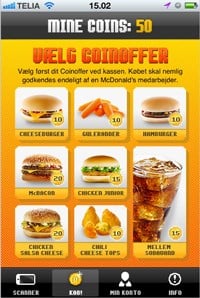Going coin hunting with McDonald's
Each QR code could be scanned once a day and only four codes could be collected each day. Customers had to collect a minimum of ten coins to redeem a menu item. The messages were generally good at driving sales. However, studies showed that customers don't buy into the programme because of brand relation - they do it because it is cheap and convenient. With the increased competitive situation in Denmark it was clear that McDonald's had to differentiate its communication in its value range - otherwise they would be an easy target for price-orientated attacks, from among others, Burger King.
Reacting and reaching out - on multiple platforms
As the target audience was moving away from traditional platforms, in favour of digital media, McDonald's had to react and evolve in to a brand that could connect and engage on multiple platforms instead of just pushing messages. The first step was initialised in October 2010, with the creation of a Facebook page. With the foundation for interaction established - McDonald's had to build on top of this, ensuring a strong relationship with its consumers and build engagement.
In order to build differentiation into the value programme it established a brand connection - and not just a 'price connection.' At the same time it aimed to maintain the perception of the programme so that its customer's perception of the price remained the same, otherwise it would risk losing sales to its competitors.
The strategy was to create its own digital currency - one that could be earned by user engagement. The currency was built as an extension to the current programme so it didn't compromise with the current setup, then making it possible for the customers to create a digital wallet by downloading an app from both the iTunes App Store and the Android Market, and start collecting digital coins. For these coins the customers could then buy products within the 'Coinoffers' range at the McDonald's restaurants. McDonald's decided to distribute 1 million coins which customers could collect and spend in the restaurants. To encourage people to download the app, the first 25 000 people received 5 coins for free, meaning that they were half way to a free 'Coinoffers' product.
'Pixel coded' coins
The coins were conventional QR-codes transformed into 'pixel codes' so they looked like a hamburger, fries etc. Beside the QR-codes a scanable sound-code was created to be used for TV, radio and cinema. McDonald's distributed the coins on a variety of media - TV, display banners, mobile banners, Facebook ads, cinema, radio, out-of-home posters, digital screens in trains and buses and on its Facebook and YouTube pages. Furthermore, it engaged with key bloggers up-front so they could spread the word about the concept to all its followers.
To increase the engagement the creative direction was to tell people to open the App - and then 10-15 seconds later the QR / Voice code appeared for scanning. In radio, two spots ran each break - the first preparing people and the second with the sound code. The campaign was scheduled to last 6 weeks, but all the Coins were collected after only 26 days meaning that McDonald's had to stop the campaign more than 2 weeks before planned.
Results
The App became the fastest downloaded commercial App in Denmark ever - reaching number 1 on iTunes App Store and Android Market only days after its release.
Considering less than 50% of the population has a smartphone, 191 417 Apps were downloaded - equal to 3.5% of the entire Danish population.
The 1 million coins were collected in just 26 days and with an estimated 10 seconds per scan, our customers have spent a total of 10 million seconds with our brand - and this is without the downloading of the App and the exchange in the restaurants.
During the campaign McDonald's reached 2 million Facebook impressions, and a Facebook engagement rate of 4.20% plus hitting the magic 100 000 likers mark. Furthermore, its YouTube channel had 280 000 views, and finally it had 475 000 unofficial YouTube views which were created and viewed by customers.
Whenever a customer spent 10 virtual coins they spent 19.27 actual Danish Kroner at the same time, resulting in a ROI of almost 2.
Source: Cream: Inspiring Innovation
Cream is a curated, global case study gallery of excellence, providing the marketing community with the latest trends and inspiration to help grow their business.
Go to: http://www.creamglobal.com






